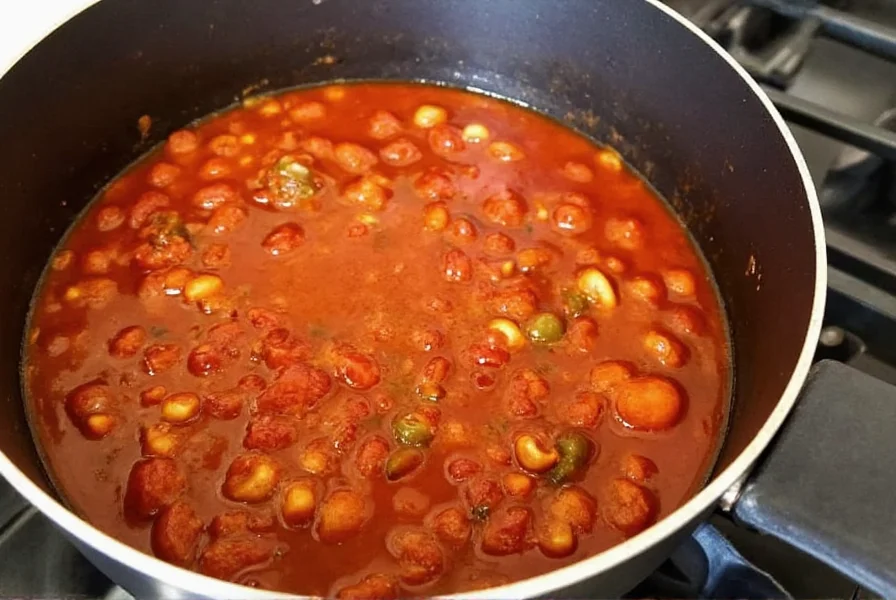Thickening chili properly transforms it from a soupy disappointment to a hearty, restaurant-quality dish. Whether you've accidentally added too much liquid or simply prefer a denser texture, understanding the science behind thickening ensures your chili achieves that perfect spoon-standing consistency without compromising flavor.
Why Your Chili Might Need Thickening
Chili often turns out too thin when recipes don't account for ingredient moisture content, particularly from canned tomatoes or beans. The ideal chili texture should coat the back of a spoon but still flow slowly—neither watery nor paste-like. Proper thickening concentrates flavors while creating that satisfying mouthfeel characteristic of authentic chili.
Top 5 Methods to Make Chili Thicker
1. Simmer Uncovered (The Natural Reduction Method)
This simplest technique requires no additional ingredients. Bring your chili to a gentle simmer, then reduce heat to low and cook uncovered for 20-30 minutes, stirring occasionally. As water evaporates, the chili naturally thickens while flavors intensify. This method works best when you have extra time before serving.

2. Tomato Paste Boost
Add 2-3 tablespoons of tomato paste during the last 15 minutes of cooking. The concentrated solids in tomato paste absorb excess liquid while enhancing the chili's rich, savory base. Stir thoroughly to prevent clumping. This approach works particularly well for tomato-based chili recipes and adds depth of flavor.
3. Cornstarch Slurry (Quick Fix)
For immediate thickening, create a slurry by mixing 1 tablespoon cornstarch with 2 tablespoons cold water until smooth. Gradually whisk into simmering chili and cook for 2-3 minutes until thickened. Use this method sparingly—excessive cornstarch can create a gummy texture. This technique is ideal when you're short on time before serving.
| Thickening Method | Time Required | Flavor Impact | Best For |
|---|---|---|---|
| Simmer Uncovered | 20-30 min | Concentrates existing flavors | All chili types |
| Tomato Paste | 10-15 min | Enhances savory notes | Tomato-based chili |
| Cornstarch Slurry | 2-3 min | Neutral | Emergency thickening |
| Mashed Beans | 5-10 min | Adds bean flavor | Bean chili varieties |
| Masa Harina | 5-7 min | Subtle corn flavor | Authentic Tex-Mex chili |
4. Mashed Beans Technique
Remove one cup of chili (primarily beans and liquid), mash thoroughly, then return to the pot. The released starches and broken-down bean structure create natural thickening. This method works especially well for bean-heavy chili recipes and maintains the dish's integrity without adding foreign ingredients.
5. Masa Harina Addition
Stir in 1-2 tablespoons of masa harina (corn flour) during the final 10 minutes of cooking. Authentic to traditional chili recipes, masa harina adds a subtle corn flavor while providing excellent thickening power. Dissolve it in a small amount of warm chili liquid first to prevent clumping.
Avoid These Common Thickening Mistakes
Many home cooks make critical errors when trying to thicken chili. Adding flour directly to hot chili creates lumps that won't dissolve. Over-thickening early in the cooking process prevents flavors from properly developing. Using breadcrumbs or crackers dilutes the chili's authentic flavor profile. And turning up the heat to speed evaporation often results in scorched底部 and uneven texture.
The Science Behind Perfect Chili Thickness
Effective thickening relies on understanding starch gelatinization and liquid reduction. Starch molecules absorb water and swell when heated, creating viscosity. Simmering uncovered allows water molecules to escape as vapor while concentrating solids. The ideal chili maintains a balance where starches provide structure without overwhelming the dish's natural ingredients. Temperature control is crucial—boiling too vigorously breaks down starch networks, while too-low heat prevents proper thickening.
Troubleshooting Thin Chili
If your chili remains too thin after initial attempts, combine methods strategically. Start with simmering uncovered for 15 minutes, then add a small amount of tomato paste. If still too thin, incorporate a minimal cornstarch slurry (1 tsp cornstarch + 2 tsp water). Remember that chili continues thickening slightly as it cools, so avoid over-correcting. For immediate serving needs, the cornstarch method provides the quickest solution without compromising flavor.
How to Prevent Runny Chili in Future Batches
Proactive measures yield better results than fixing thin chili after cooking. Drain excess liquid from canned ingredients before adding them. Use less broth or water initially—you can always add more liquid but can't remove it. Incorporate thickening ingredients early in the cooking process to allow proper integration. And remember that different beans release varying amounts of starch, with kidney beans providing more natural thickening than black beans.











 浙公网安备
33010002000092号
浙公网安备
33010002000092号 浙B2-20120091-4
浙B2-20120091-4